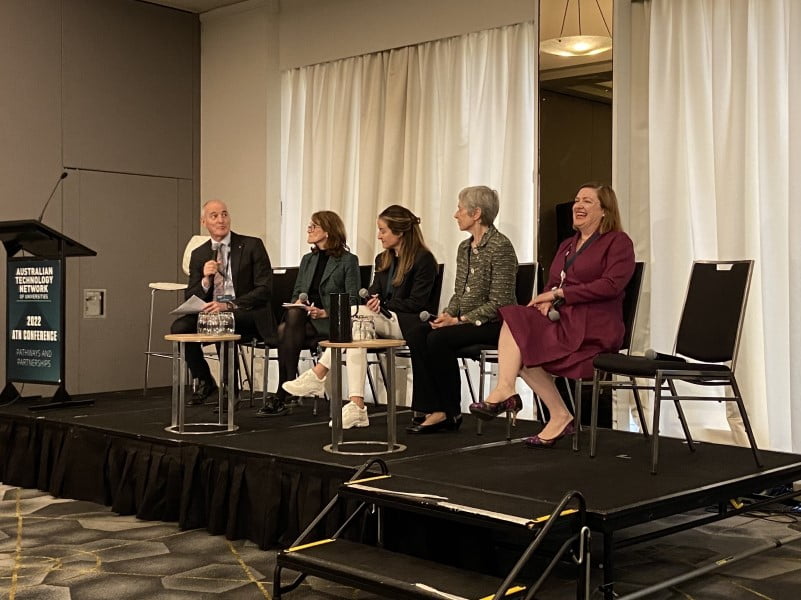Australia’s chief scientist has highlighted the importance of not limiting the scope of fundamental research and suggested it shouldn’t be bound by national research priorities.
Dr Cathy Foley was speaking on a panel at the Australian Technology Network for Universities conference on Tuesday alongside Australia’s chief defence scientist Professor Tanya Monro, National Health and Medical Research Council chief executive Professor Anne Kelso, and Scale Investors co-chief executive Samar McHeileh.
“I think we need to be aware of the fact that fundamental research, basic research actually should be… about discovery. It shouldn’t be limited by having priority areas because, ‘we don’t know what we don’t know’, that’s part of the role of universities,” Dr Foley said.
“You have to do fundamental work that no one’s thought of before and that’s where the new things come that we don’t even realise we need yet, [that changes the world, and is disruptive]. But we’ve got to give that runway to be able to do that.”
Australia’s chief scientist is currently leading a review of Australia’s national science and research priorities which will be published in 12 months’ time. This aims to align direct investment towards sectors that require long-term support to scale, which would include activity such as applied research.

Dr Foley added that fundamental research must be supported without any constraints. It is also important to ensure there is sufficient funding, which remains “one of the challenges”.
Professor Kelso also backed the call to support fundamental research and noted that measuring the impact of research and development can also be measured in terms of its effect on knowledge, among several other indicators.
“We’re thinking really broadly about impact because we’re talking about health research, our purpose of the NHMRC… is to improve human health. Commercialisation is one pathway to impact but it’s not the only pathway to health impact,” Professor Kelso said.
“We’re interested in clinical procedures, we’re interested in public health interventions, we’re interested in research that improves the way health services are delivered efficiently and effectively to the community.”
She also argued that academics should shift measurements of productivity away from “publication numbers, citations, conference invitations, [and] invitations to peer review… which I think are of absolutely no interest to the general community, and not that relevant, and also not terribly interesting to our ministers”.
In an attempt to help shift their thinking, Dr Kelso notes the NHMRC now asks researchers applying for funding to share their top 10 publications, rather than all of them, and considers their “past research impact”.
From a Defence perspective, Professor Monro notes that research and development impact is simple to define.
“The sobering fact when we’re doing research and development in this space is, unless our [Australian Defence Force] can field it, it is not [having impact],” Professor Monro said.
“That is the cold hard reality now. In order to give our government the most options they need a broad range of capability choices. In terms of what that means for methodology, I think it actually should trigger a very useful conversation because I know that has different flavours for different parts of government… but in the defence context, I think we probably have one of the cleanest, clearest definitions because of the nature of our work.”
Although Defence research and development impact is easy to define, Professor Monro noted earlier in the panel discussion that it is the responsibility of government to communicate its needs to industry. In particular, she wants to increase the mobility of people between the public and private sector.
“I realised when I took on this role that I couldn’t expect my organisation Defence Science and Technology Group (DSTG) to suddenly, under our ‘More, Together’ strategy become more outward facing. We needed to make sure that we had people within our organisation who’ve worked in universities, who’ve worked in industry, [and] who’ve been entrepreneurs, in order to understand how we needed to work differently,” Professor Monro said.
“We’ve been doing that. The most recent… piece is the Navigate program, which is a mid-career graduate program to [bring post-PhDs into DSTG] and my people out, at that same mid-career level and to your organisation’s to spread that awareness of how to work across sectors.”
Ms McHeileh emphasised the importance of a joint university, research, industry and government approach to funding startups and spinouts. She noted that venture capital cannot fill this gap alone, “especially when it comes to the gender investment gap, it’s in fact widening”. As an example, she noted that early-stage companies generally do not have the funding to for “a proper parental leave policy”, which opens a clear space for government support or for corporate venture capital.
When the panel was asked what should be done to ensure there is an appropriate distribution of funding across different areas of research, Dr Foley noted this is partly due to low levels of business expenditure on research and development, “the lowest in the OECD”.
Do you know more? Contact James Riley via Email.

